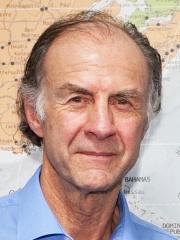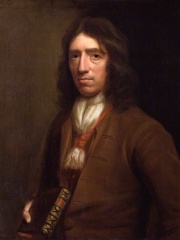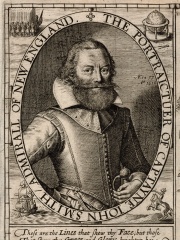
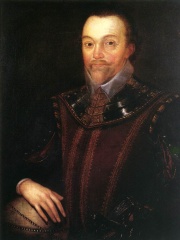
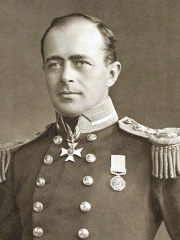
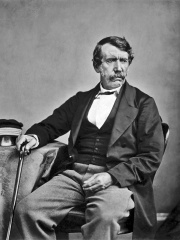
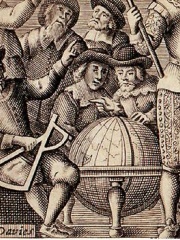
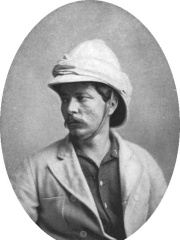
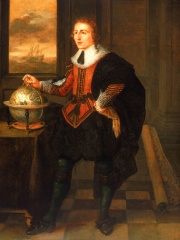
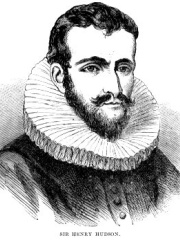
The Most Famous
EXPLORERS from United Kingdom
This page contains a list of the greatest British Explorers. The pantheon dataset contains 498 Explorers, 84 of which were born in United Kingdom. This makes United Kingdom the birth place of the most number of Explorers.
Top 10
The following people are considered by Pantheon to be the top 10 most legendary British Explorers of all time. This list of famous British Explorers is sorted by HPI (Historical Popularity Index), a metric that aggregates information on a biography's online popularity. Visit the rankings page to view the entire list of British Explorers.

1. James Cook (1728 - 1779)
With an HPI of 84.14, James Cook is the most famous British Explorer. His biography has been translated into 161 different languages on wikipedia.
Captain James Cook (7 November 1728 – 14 February 1779) was a British Royal Navy officer, explorer, and cartographer who led three voyages of exploration to the Pacific and Southern Oceans between 1768 and 1779. He completed the first recorded circumnavigation of the main islands of New Zealand, and led the first recorded visit by Europeans to the east coast of Australia and the Hawaiian Islands. Cook joined the British merchant navy as a teenager before enlisting in the Royal Navy in 1755. He first saw combat during the Seven Years' War, when he fought in the Siege of Louisbourg. Later in the war he surveyed and mapped much of the entrance to the St. Lawrence River during the Siege of Quebec. In the 1760s he mapped the coastline of Newfoundland and made important astronomical observations which brought him to the attention of the Admiralty and the Royal Society. This acclaim came at a pivotal moment in British overseas exploration, and it led to his commission in 1768 as commander of HMS Endeavour for the first of his three voyages. During these voyages he sailed tens of thousands of miles across largely uncharted areas, mapping coastlines, islands, and features across the globe in greater detail than previously charted – including Easter Island, Alaska, and South Georgia Island. He made contact with numerous indigenous peoples, and claimed several territories for the Kingdom of Great Britain. Renowned for exceptional seamanship and courage in times of danger, he was patient, persistent, sober, and competent, but sometimes hot-tempered. His contributions to the prevention of scurvy, a disease common among sailors, led the Royal Society to award him the Copley Gold Medal. In 1779, during his second visit to Hawaii, Cook was killed when a dispute with Native Hawaiians turned violent. His voyages left a legacy of scientific and geographical knowledge that influenced his successors well into the 20th century. Numerous memorials have been dedicated to him worldwide.

2. Francis Drake (1540 - 1596)
With an HPI of 81.71, Francis Drake is the 2nd most famous British Explorer. His biography has been translated into 110 different languages.
Sir Francis Drake (c. 1540 – 28 January 1596) was an English explorer and privateer best known for making the second circumnavigation of the world in a single expedition between 1577 and 1580 (being the first English expedition to accomplish this). He is also known for participating in the early English slaving voyages of his cousin, John Hawkins, and John Lovell. Having started as a simple seaman, in 1588 he was part of the fight against the Spanish Armada as a vice admiral. At an early age, Drake was placed into the household of a relative, William Hawkins, a prominent sea captain in Plymouth. In 1572, he set sail on his first independent mission, privateering along the Spanish Main. Drake's circumnavigation began on 15 December 1577. He crossed the Pacific Ocean, until then an area of exclusive Spanish interest, and laid claim to New Albion, plundering coastal towns and ships for treasure and supplies as he went. He arrived back in England on 26 September 1580. Elizabeth I awarded Drake a knighthood in 1581 which he received aboard his galleon the Golden Hind. Drake's circumnavigation inaugurated an era of conflict with the Spanish and in 1585, the Anglo-Spanish War began. Drake was in command of an expedition to the Americas that attacked Spanish shipping and ports. When Philip II sent the Spanish Armada to England in 1588 as a precursor to its invasion, Drake was second-in-command of the English fleet that fought against and repulsed the Spanish fleet. A year later he led the English Armada in a failed attempt to destroy the remaining Spanish fleet. Drake was a Member of Parliament (MP) for three constituencies: Camelford in 1581, Bossiney in 1584, and Plymouth in 1593. Drake's exploits made him a hero to the English, but his privateering led the Spanish to brand him a pirate, known to them as El Draque ("The Dragon" in old Spanish). He died of dysentery after his failed assault on Panama in January 1596.

3. Robert Falcon Scott (1868 - 1912)
With an HPI of 80.52, Robert Falcon Scott is the 3rd most famous British Explorer. His biography has been translated into 67 different languages.
Captain Robert Falcon Scott (6 June 1868 – c. 29 March 1912) was a British Royal Navy officer and explorer who led two expeditions to the Antarctic regions: the Discovery expedition of 1901–04 and the Terra Nova expedition of 1910–13. On the first expedition, Scott set a new southern record by marching to latitude 82°S and discovered the Antarctic Plateau, on which the South Pole is located. On the second venture, Scott led a party of five which reached the South Pole on 17 January 1912, less than five weeks after Amundsen's South Pole expedition. On the return journey from the Pole, a planned meeting with supporting dog teams from the base camp failed, despite Scott's written instructions, and at a distance of 162 miles (261 km) from their base camp at Hut Point and approximately 12.5 miles (20.1 km) from the next depot, Scott and his companions died. When Scott and his party's bodies were discovered, they had in their possession the first Antarctic fossils discovered. The fossils were determined to be from the Glossopteris tree and proved that Antarctica was once forested and joined to other continents. Before his appointment to lead the Discovery expedition, Scott had a career as a Royal Navy officer. In 1899, he had a chance encounter with Sir Clements Markham, the president of the Royal Geographical Society (RGS), and learned of a planned Antarctic expedition, which he soon volunteered to lead. His name became inseparably associated with the Antarctic, the field of work to which he remained committed during the final years of his life. Following the news of his death, Scott became a celebrated hero, a status reflected by memorials erected across the UK. However, in the last decades of the 20th century, questions were raised about his competence and character. Commentators in the 21st century have regarded Scott more positively after assessing the temperature drop below −40 °C (−40 °F) in March 1912, and after re-discovering Scott's written orders of October 1911, in which he had instructed the dog teams to meet and assist him on the return trip.

4. David Livingstone (1813 - 1873)
With an HPI of 77.19, David Livingstone is the 4th most famous British Explorer. His biography has been translated into 88 different languages.
David Livingstone (; 19 March 1813 – 1 May 1873) was a Scottish doctor, Congregationalist, pioneer Christian missionary with the London Missionary Society, and an explorer in Africa. Livingstone was married to Mary Moffat Livingstone, from the prominent 18th-century Moffat missionary family. Livingstone came to have a mythic status as a Protestant missionary martyr, working-class "rags-to-riches" inspirational story, scientific investigator and explorer, imperial reformer, anti-slavery crusader, and advocate of British commercial and colonial expansion. As a result, he became one of the most popular British heroes of the late 19th-century Victorian era. Livingstone's fame as an explorer and his obsession with learning the sources of the Nile was founded on the belief that if he could solve that age-old mystery, his fame would give him the influence to end the East African Arab–Swahili slave trade. "The Nile sources", he told a friend, "are valuable only as a means of opening my mouth with power among men. It is this power [with] which I hope to remedy an immense evil." His subsequent exploration of the central African watershed was the culmination of the classic period of European geographical discovery and colonial penetration of Africa. At the same time, his missionary travels, "disappearance" and eventual death in Africa—and subsequent glorification as a posthumous national hero in 1874—led to the founding of several major central African Christian missionary initiatives carried forward in the era of the European "Scramble for Africa", during which almost all of Africa fell under European rule for decades.
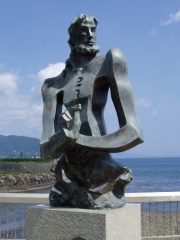
5. William Adams (1564 - 1620)
With an HPI of 75.97, William Adams is the 5th most famous British Explorer. His biography has been translated into 32 different languages.
William Adams (24 September 1564 – 16 May 1620), better known in Japan as Miura Anjin (三浦按針; 'the pilot of Miura'), was an English navigator who, in 1600, became the first Englishman to reach Japan. He was later granted samurai status, and was recognised as one of the most influential foreigners in Japan during the early 17th century. He arrived in Japan as one of the few survivors of the ship Liefde under the leadership of Jacob Quaeckernaeck. It was the only vessel to reach Japan from a five-ship expedition launched by a company of Rotterdam merchants (a voorcompagnie, or predecessor, of the Dutch East India Company). Soon after his arrival in Japan, Adams and his second mate Jan Joosten became advisors to shōgun Tokugawa Ieyasu, and each was appointed as hatamoto. For more than a decade, the Tokugawa authorities did not allow Adams and Joosten to leave Japan. Although eventually given permission to return home to England, Adams decided to stay in Japan, where he died at the age of 55. In 1635, Tokugawa Iemitsu closed Japan to foreign trade and Adams's half-Japanese children disappear from historical records at that time.

6. John Davis (1550 - 1605)
With an HPI of 74.69, John Davis is the 6th most famous British Explorer. His biography has been translated into 37 different languages.
John Davis (c. 1550 – 29 December 1605) was one of the chief navigators of Queen Elizabeth I of England. He led several voyages to discover the Northwest Passage and served as pilot and captain on both Dutch and English voyages to the East Indies. He discovered the Falkland Islands in August 1592.

7. Henry Morton Stanley (1841 - 1904)
With an HPI of 72.31, Henry Morton Stanley is the 7th most famous British Explorer. His biography has been translated into 67 different languages.
Sir Henry Morton Stanley (born John Rowlands; 28 January 1841 – 10 May 1904) was a Welsh-American explorer, journalist, soldier, colonial administrator, author, and politician famous for his exploration of Central Africa and search for missionary and explorer David Livingstone. Besides his discovery of Livingstone, he is mainly known for his search for the sources of the Nile and Congo rivers, the work he undertook as an agent of King Leopold II of the Belgians that enabled the occupation of the Congo Basin region, and his command of the Emin Pasha Relief Expedition. He was knighted in 1897, and served in Parliament as a Liberal Unionist member for Lambeth North from 1895 to 1900. More than a century after his death, Stanley's legacy remains the subject of enduring controversy. Although he personally had high regard for many of the native African people who accompanied him on his expeditions, the exaggerated accounts of corporal punishment and brutality in his books fostered a public reputation as a hard-driving, cruel leader, in contrast to the supposedly more humanitarian Livingstone. His contemporary image in Britain also suffered from the perception that he was American. In the 20th century, his reputation was also seriously damaged by his role in establishing the Congo Free State for King Leopold II. Nevertheless, he is recognised for his important contributions to Western knowledge of the geography of Central Africa and for his resolute opposition to the slave trade in East Africa.

8. William Baffin (1584 - 1622)
With an HPI of 72.23, William Baffin is the 8th most famous British Explorer. His biography has been translated into 50 different languages.
William Baffin (c. 1584 – 23 January 1622) was an English navigator, explorer and cartographer. He is best known for his attempt to find the Northwest Passage from the Atlantic to Pacific oceans, during which Baffin became the first European to discover a bay which was subsequently named in his honour. Baffin carried out numerous surveys of the Red Sea and Persian Gulf for the English East India Company.

9. Henry Hudson (1570 - 1611)
With an HPI of 71.66, Henry Hudson is the 9th most famous British Explorer. His biography has been translated into 69 different languages.
Henry Hudson (c. 1565 – disappeared 23 June 1611) was an English sea explorer and navigator during the early 17th century, best known for his explorations of present-day Canada and parts of the Northeastern United States. In 1607 and 1608, Hudson made two attempts on behalf of English merchants to find a rumoured Northeast Passage to Cathay via a route above the Arctic Circle. In 1609, he landed in North America on behalf of the Dutch East India Company and explored the region around the modern New York metropolitan area. Looking for a Northwest Passage to Asia on his ship Halve Maen ("Half Moon"), he sailed up the Hudson River, which was later named after him, and thereby laid the foundation for Dutch colonization of the region. His contributions to the exploration of the New World were significant and lasting. His voyages helped to establish European contact with the native peoples of North America and contributed to the development of trade and commerce. On his final expedition, while still searching for the Northwest Passage, Hudson became the first European to see Hudson Strait and the immense Hudson Bay. In 1611, after wintering on the shore of James Bay, Hudson wanted to press on to the west, but most of his crew mutinied. The mutineers cast Hudson, his son, and six others adrift; what then happened to the Hudsons and their companions is unknown.
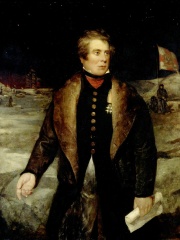
10. John Ross (1777 - 1856)
With an HPI of 70.44, John Ross is the 10th most famous British Explorer. His biography has been translated into 31 different languages.
Rear-Admiral Sir John Ross (24 June 1777 – 30 August 1856) was a British naval officer and explorer. He was the uncle of Sir James Clark Ross, who explored the Arctic with him, and later led expeditions to Antarctica.
People
Pantheon has 84 people classified as British explorers born between 1521 and 1976. Of these 84, 3 (3.57%) of them are still alive today. The most famous living British explorers include Ranulph Fiennes, Ed Stafford, and Ellen MacArthur. The most famous deceased British explorers include James Cook, Francis Drake, and Robert Falcon Scott.
Living British Explorers
Go to all RankingsRanulph Fiennes
1944 - Present
HPI: 65.53
Ed Stafford
1975 - Present
HPI: 53.66
Ellen MacArthur
1976 - Present
HPI: 51.08
Deceased British Explorers
Go to all RankingsJames Cook
1728 - 1779
HPI: 84.14
Francis Drake
1540 - 1596
HPI: 81.71
Robert Falcon Scott
1868 - 1912
HPI: 80.52
David Livingstone
1813 - 1873
HPI: 77.19
William Adams
1564 - 1620
HPI: 75.97
John Davis
1550 - 1605
HPI: 74.69
Henry Morton Stanley
1841 - 1904
HPI: 72.31
William Baffin
1584 - 1622
HPI: 72.23
Henry Hudson
1570 - 1611
HPI: 71.66
John Ross
1777 - 1856
HPI: 70.44
William Dampier
1651 - 1715
HPI: 70.31
John Smith
1580 - 1631
HPI: 69.66
Overlapping Lives
Which Explorers were alive at the same time? This visualization shows the lifespans of the 25 most globally memorable Explorers since 1700.

